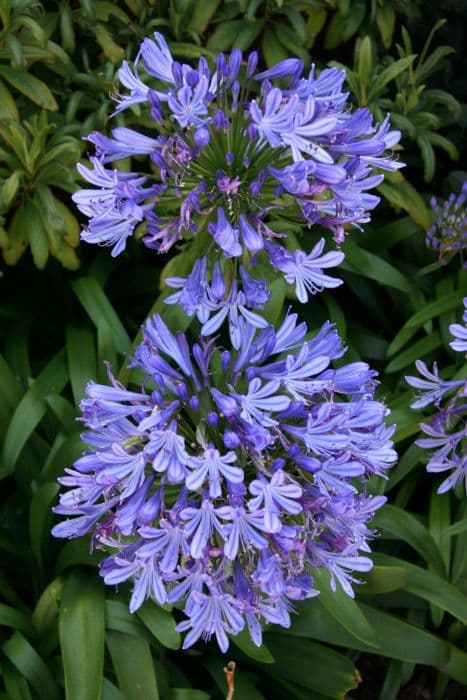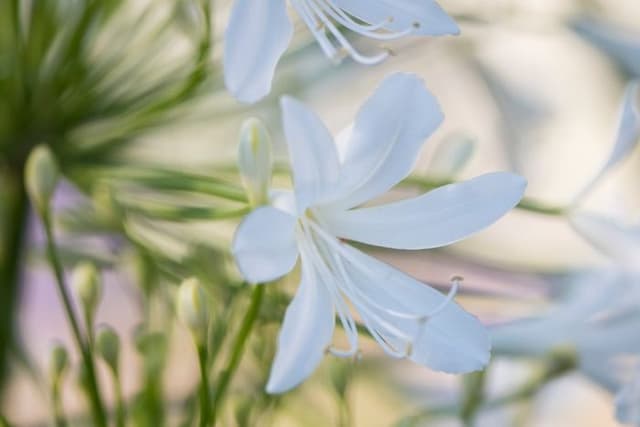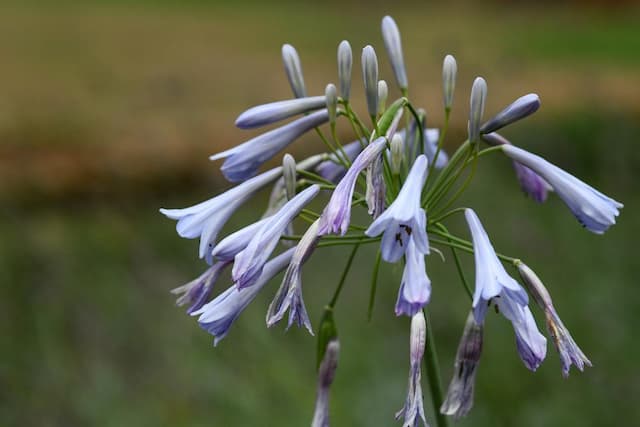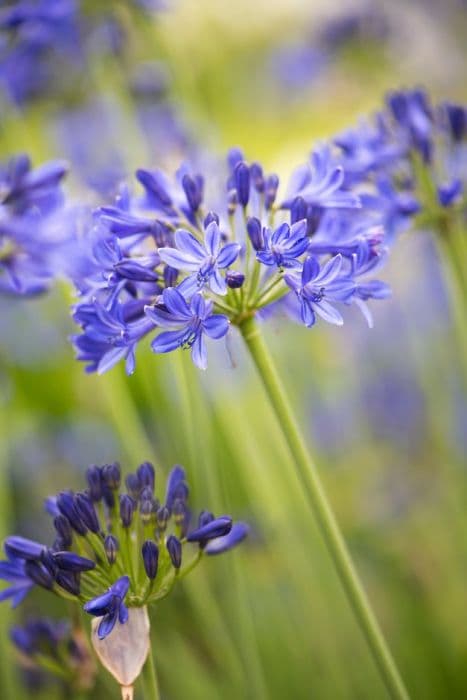African Lily Agapanthus 'Blue Magic'
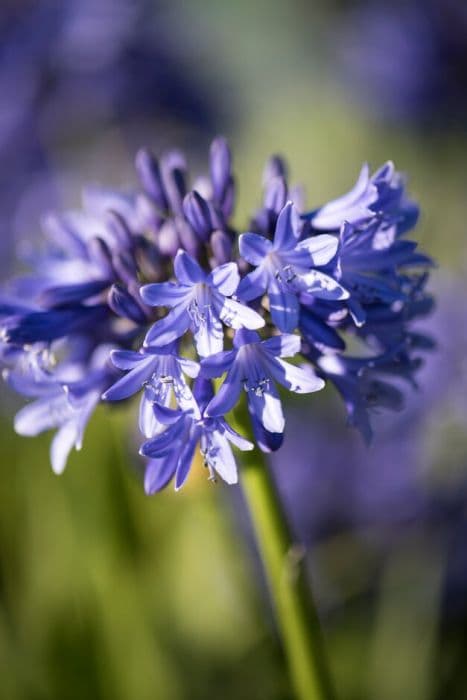
ABOUT
The Agapanthus 'Blue Magic', commonly known as the Lily of the Nile, is a perennial plant that is known for its striking floral display. It features clumps of strap-shaped, glossy green leaves that provide a lush, mounded backdrop for the flowers. The true allure of 'Blue Magic' lies in its enchanting blooms. In mid to late summer, it produces rounded clusters of funnel-shaped, deep blue flowers. These blooms are neatly arranged in large, spherical umbels at the end of sturdy, vertical stalks that rise above the foliage like exquisite floral globes. The contrast between the rich blue petals and the green leaves creates a visually stunning effect in garden settings. The flowers are a favorite among butterflies and bees, adding an extra layer of liveliness to its display. Overall, Agapanthus 'Blue Magic' is a beloved plant for its easy care and breathtaking beauty that adds a touch of magic to any landscape with its cool blue tones.
About this plant
 Names
NamesFamily
Amaryllidaceae.
Synonyms
African Lily, Lily of the Nile, Blue African Lily.
Common names
Agapanthus 'Blue Magic'.
 Toxicity
ToxicityTo humans
Agapanthus, commonly known as Lily of the Nile, contains several toxic compounds that can be harmful if ingested. The whole plant is considered poisonous, with the highest concentration of toxins typically found in the roots and sap. When parts of the plant are ingested by humans, it can cause symptoms such as nausea, vomiting, abdominal pain, and diarrhea. In severe cases, ingestion can lead to more serious effects like tremors or cardiac issues. It is advised to avoid consuming any part of the Lily of the Nile and to seek medical attention if ingestion is suspected.
To pets
Agapanthus, also known as Lily of the Nile, is toxic to pets, including cats and dogs. The plant contains substances that can cause gastrointestinal upset, such as vomiting and diarrhea, if ingested. In some cases, more severe symptoms may occur, such as lethargy, drooling, and nausea. Consumption of large quantities can lead to more serious health problems, including tremors or cardiac issues. If you suspect that your pet has ingested any part of the Lily of the Nile, it is important to contact a veterinarian as soon as possible.
 Characteristics
CharacteristicsLife cycle
Perennials
Foliage type
Evergreen
Color of leaves
Green
Flower color
Blue
Height
2 feet [60 cm]
Spread
2 feet [60 cm]
Plant type
Bulb
Hardiness zones
8
Native area
South Africa
Benefits
 General Benefits
General Benefits- Ornamental appeal: Agapanthus 'Blue Magic', often referred to as Lily of the Nile, displays vibrant blue flowers that add aesthetic beauty to any garden setting.
- Drought tolerance: Once established, this plant is relatively drought-tolerant, making it suitable for water-wise gardens.
- Low maintenance: Lily of the Nile requires minimal care, making it an ideal choice for busy gardeners or those new to gardening.
- Attracts pollinators: The flowers can attract bees, butterflies, and other pollinators, promoting biodiversity in the garden.
- Long blooming season: Its blooming season extends through the summer months, providing long-lasting color and interest.
- Container gardening: Suitable for potting, this plant can be grown in containers for patios, balconies, or to accentuate different parts of the garden.
- Border and accent plant: It works well as an accent plant or border within landscape designs due to its clumping habit and striking blooms.
- Cut flowers: The long stems and attractive blooms of the Lily of the Nile are excellent for creating fresh or dried floral arrangements.
 Medical Properties
Medical PropertiesThis plant is not used for medical purposes.
 Air-purifying Qualities
Air-purifying QualitiesThis plant is not specifically known for air purifying qualities.
 Other Uses
Other Uses- Agapanthus 'Blue Magic', commonly known as Lily of the Nile, can be used as cut flowers in floral arrangements due to their long stalks and vibrant blooms, lasting up to two weeks in a vase.
- Lily of the Nile can be used as a natural dye for fabrics, its flowers imparting a subtle blue or purple hue when treated appropriately.
- These plants can be used to stabilize soil in erosion-prone areas, as their root systems are robust and can help hold the soil together.
- Lily of the Nile is an excellent choice for themed gardens, such as 'blue gardens' or 'moon gardens', where the color and bloom time are specifically curated for certain aesthetics.
- Because of their striking appearance, Lily of the Nile can be used in art and photography projects, serving as an exotic subject or backdrop.
- They can be planted in containers and used as patio or balcony plants, providing outdoor living spaces with lush, floral decor.
- Agapanthus 'Blue Magic' can act as a temporary privacy screen in summer when planted closely in rows due to their dense foliage and tall flower stems.
- This plant can be incorporated into educational programs about pollination, serving as a living example to demonstrate the process to students and gardening enthusiasts.
- Lily of the Nile can also serve as a living sculpture in topiary gardens, where their globular flower heads can be used to create visual interest and structure.
- These plants are sometimes used in the culinary field as an ornamental garnish, although they are not edible.
Interesting Facts
 Feng Shui
Feng ShuiThe Agapanthus, also known as African Lily, is not typically used in Feng Shui practice.
 Zodiac Sign Compitability
Zodiac Sign CompitabilityThe African Lily is not used in astrology practice.
 Plant Symbolism
Plant Symbolism- Love Letters: Agapanthus, often known as Lily of the Nile, has been associated with love and can be thought of as a symbol of carrying messages or love letters between parted lovers.
- Beauty: With its striking blue flowers, the 'Blue Magic' variety of Agapanthus is particularly symbolic of beauty and splendor in the natural world.
- Fertility: Due to its lush and bountiful floral displays, Agapanthus can represent fertility and abundance.
 Water
WaterThe Lily of the Nile should be watered once every week, making sure the soil is moist but well-drained. During the active growing season in spring and summer, water with about two to three gallons depending on the size of your plant and the weather conditions. Reduce watering in the fall and further in the winter to prevent waterlogging, especially during periods of low temperatures when the plant requires less moisture.
 Light
LightLily of the Nile thrives in full sun to partial shade. The ideal spot is where the plant receives direct sunlight for at least six hours a day, but it can also tolerate some light afternoon shade. Avoid deep shade as this can hamper bloom production and overall vitality.
 Temperature
TemperatureLily of the Nile prefers a temperature range of 60°F to 80°F; however, it can survive in temperatures as low as 50°F and can withstand up to about 90°F. The ideal conditions are when nighttime temperatures are cooler than daytime, fostering better growth and bloom cycles.
 Pruning
PruningPruning Lily of the Nile promotes healthier growth and improved flowering. Right after the flowers fade, deadhead the plant to encourage a second bloom. It’s also beneficial to cut back the foliage in late fall or early winter, after it has died back, usually doing this once a year.
 Cleaning
CleaningAs needed
 Soil
SoilAfrican Lily 'Blue Magic' thrives in a soil mix that is well-draining and rich in organic matter. A blend of two parts loam, one part peat or compost, and one part sharp sand or perlite works well. The ideal soil pH is slightly acidic to neutral, ranging from 6.0 to 7.0.
 Repotting
RepottingAfrican Lily 'Blue Magic' does not require frequent repotting and can be done every 3-4 years. They prefer to be somewhat root-bound, so only repot when the roots have completely filled the pot.
 Humidity & Misting
Humidity & MistingAfrican Lily 'Blue Magic' is adaptable to most humidity levels but prefers moderate humidity. Strive for a humidity level between 40-60% for optimal growth.
 Suitable locations
Suitable locationsIndoor
Place in bright, indirect light and keep soil evenly moist.
Outdoor
Plant in sun or part-shade and protect from harsh frosts.
Hardiness zone
8-11 USDA
 Life cycle
Life cycleAgapanthus 'Blue Magic', commonly known as Lily of the Nile or African Lily, starts its life cycle when the seed germinates, typically in spring or early summer. The seedling grows into a vegetative plant, developing long, strappy leaves and a robust root system. As the plant matures, it enters the flowering stage, usually in the summer, where it produces tall, striking flower stalks with clusters of blue trumpet-shaped flowers. After pollination, if successful, the flowers will develop into seed capsules. Once the seeds mature, they are dispersed by wind or other means, and the cycle begins anew. In colder climates, Agapanthus enters a period of dormancy during the winter, where growth slows down significantly until conditions become favorable again in the spring.
 Propogation
PropogationPropogation time
Spring-Early Summer
The Agapanthus 'Blue Magic', commonly known as the African Lily, can be effectively propagated through division, which is the most popular method for this plant. Division is best performed in the spring before the growing season begins. This involves carefully lifting the plant from the ground and gently separating it into smaller sections, each with a portion of the root system intact. These divisions should be replanted promptly at the same soil level as they were previously growing. It is important to water the new plants well after planting to help establish them. Aim to divide every 3 to 4 years to maintain plant vigor and to ensure the continued production of abundant blue flowers. The African Lily's ability to recover quickly from division also helps to proliferate and rejuvenate older clumps, ensuring their health and beauty for many seasons.
